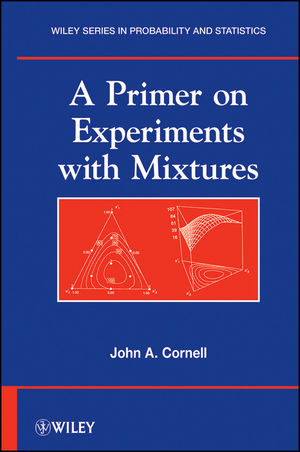A Primer on Experiments with MixturesISBN: 978-0-470-64338-9
Hardcover
384 pages
August 2011
 This is a Print-on-Demand title. It will be printed specifically to fill your order. Please allow an additional 10-15 days delivery time. The book is not returnable.
|
||||||
Preface ix
1. Introduction 1
1.1 The Original Mixture Problem 2
1.2 A Pesticide Example Involving Two Chemicals 2
1.3 General Remarks About Response Surface Methods 9
1.4 An Historical Perspective 13
References and Recommended Reading 17
Questions 17
Appendix 1A: Testing for Nonlinear Blending of the Two Chemicals Vendex and Kelthane While Measuring the Average Percent Mortality (APM) of Mites 20
2. The Original Mixture Problem: Designs and Models for Exploring the Entire Simplex Factor Space 23
2.1 The Simplex-Lattice Designs 23
2.2 The Canonical Polynomials 26
2.3 The Polynomial Coefficients as Functions of the Responses at the Points of the Lattices 31
2.4 Estimating The Parameters in the {q,m} Polynomials 34
2.5 Properties of the Estimate of the Response, ŷ(x) 37
2.6 A Three-Component Yarn Example Using A {3 2} Simplex-Lattice Design 38
2.7 The Analysis of Variance Table 42
2.8 Analysis of Variance Calculations of the Yarn Elongation Data 45
2.9 The Plotting of Individual Residuals 48
2.10 Testing the Degree of the Fitted Model: A Quadratic Model or Planar Model? 49
2.11 Testing Model Lack of Fit Using Extra Points and Replicated Observations 55
2.12 The Simplex-Centroid Design and Associated Polynomial Model 58
2.13 An Application of a Four-Component Simplex-Centroid Design: Blending Chemical Pesticides for Control of Mites 60
2.14 Axial Designs 62
2.15 Comments on a Comparison Made Between an Augmented Simplex-Centroid Design and a Full Cubic Lattice for Three Components Where Each Design Contains Ten Points 66
2.16 Reparameterizing Scheffé’s Mixture Models to Contain a Constant (β0) Term: A Numerical Example 69
2.17 Questions to Consider at the Planning Stages of a Mixture Experiment 77
2.18 Summary 78
References and Recommended Reading 78
Questions 80
Appendix 2A: Least-Squares Estimation Formula for the Polynomial Coefficients and Their Variances: Matrix Notation 85
Appendix 2B: Cubic and Quartic Polynomials and Formulas for the Estimates of the Coefficients 90
Appendix 2C: The Partitioning of the Sources in the Analysis of Variance Table When Fitting the Scheffé Mixture Models 91
3. Multiple Constraints on the Component Proportions 95
3.1 Lower-Bound Restrictions on Some or All of the Component Proportions 95
3.2 Introducing L-Pseudocomponents 97
3.3 A Numerical Example of Fitting an L-Pseudocomponent Model 99
3.4 Upper-Bound Restrictions on Some or All Component Proportions 101
3.5 An Example of the Placing of an Upper Bound on a Single Component: The Formulation of a Tropical Beverage 103
3.6 Introducing U-Pseudocomponents 107
3.7 The Placing of Both Upper and Lower Bounds on the Component Proportions 112
3.8 Formulas for Enumerating the Number of Extreme Vertices, Edges, and Two-Dimensional Faces of the Constrained Region 119
3.9 McLean and Anderson’s Algorithm for Calculating the Coordinates of the Extreme Vertices of a Constrained Region 123
3.10 Multicomponent Constraints 128
3.11 Some Examples of Designs for Constrained Mixture Regions: CONVRT and CONAEV Programs 131
3.12 Multiple Lattices for Major and Minor Component Classifications 138
Summary 154
References and Recommended Reading 155
Questions 157
4. The Analysis of Mixture Data 159
4.1 Techniques Used in the Analysis of Mixture Data 160
4.2 Test Statistics for Testing the Usefulness of the Terms in the Scheffé Polynomials 163
4.3 Model Reduction 170
4.4 An Example of Reducing the System from Three to Two Components 173
4.5 Screening Components 175
4.6 Other Techniques Used to Measure Component Effects 179
4.7 Leverage and the Hat Matrix 190
4.8 A Three-Component Propellant Example 192
4.9 Summary 195
References and Recommended Reading 196
Questions 197
5. Other Mixture Model Forms 201
5.1 The Inclusion of Inverse Terms in the Scheffé Polynomials 201
5.2 Fitting Gasoline Octane Numbers Using Inverse Terms in the Model 204
5.3 An Alternative Model Form for Modeling the Additive Blending Effect of One Component in a Multicomponent System 205
5.4 A Biological Example on the Linear Effect of a Powder Pesticide in Combination with Two Liquid Pesticides Used for Suppressing Mite Population Numbers 212
5.5 The Use of Ratios of Components 215
5.6 Cox’s Mixture Polynomials: Measuring Component Effects 219
5.7 An Example Illustrating the Fits of Cox’s Model and Scheffé’s Polynomial 224
5.8 Fitting a Slack-Variable Model 229
5.9 A Numerical Example Illustrating the Fits of Different Reduced Slack-Variable Models: Tint Strength of a House Paint 233
5.10 Summary 239
References and Recommended Reading 240
Questions 242
6. The Inclusion of Process Variables in Mixture Experiments 247
6.1 Designs Consisting of Simplex-Lattices and Factorial Arrangements 249
6.2 Measuring the Effects of Cooking Temperature and Cooking Time on the Texture of Patties Made from Two Types of Fish 251
6.3 Mixture-Amount Experiments 256
6.4 Determining the Optimal Fertilizer Blend and Rate for Young Citrus Trees 262
6.5 A Numerical Example of the Fit of a Combined Model to Data Collected on Fractions of the Fish Patty Experimental Design 269
6.6 Questions Raised and Recommendations Made When Fitting a Combined Model Containing Mixture Components and Other Variables 272
6.7 Summary 277
References and Recommended Reading 278
Questions 280
Appendix 6A: Calculating the Estimated Combined Mixture Component–Process Variable Model of Eq. (6.10) Without the Computer 282
7. A Review of Least Squares and the Analysis of Variance 285
7.1 A Review of Least Squares 285
7.2 The Analysis of Variance 288
7.3 A Numerical Example: Modeling the Texture of Fish Patties 289
7.4 The Adjusted Multiple Correlation Coefficient 293
7.5 The Press Statistic and Studentized Residuals 293
7.6 Testing Hypotheses About the Form of the Model: Tests of Significance 295
References and Recommended Reading 298
Bibliography 299
Answers to Selected Questions 317
Appendix 337
Index 347



